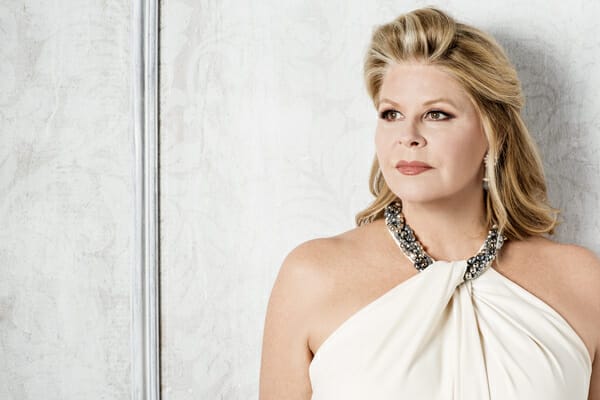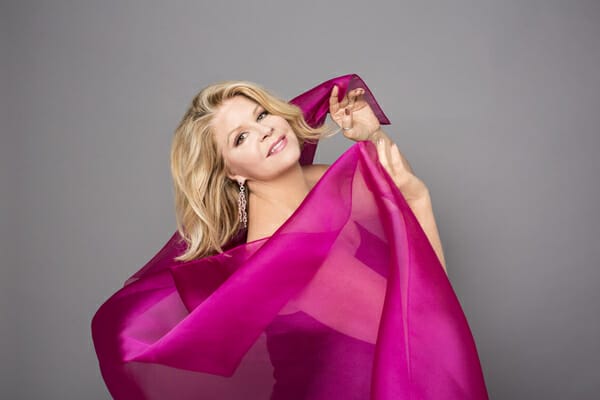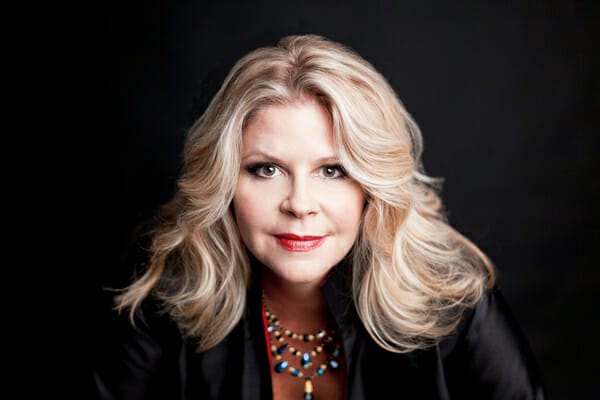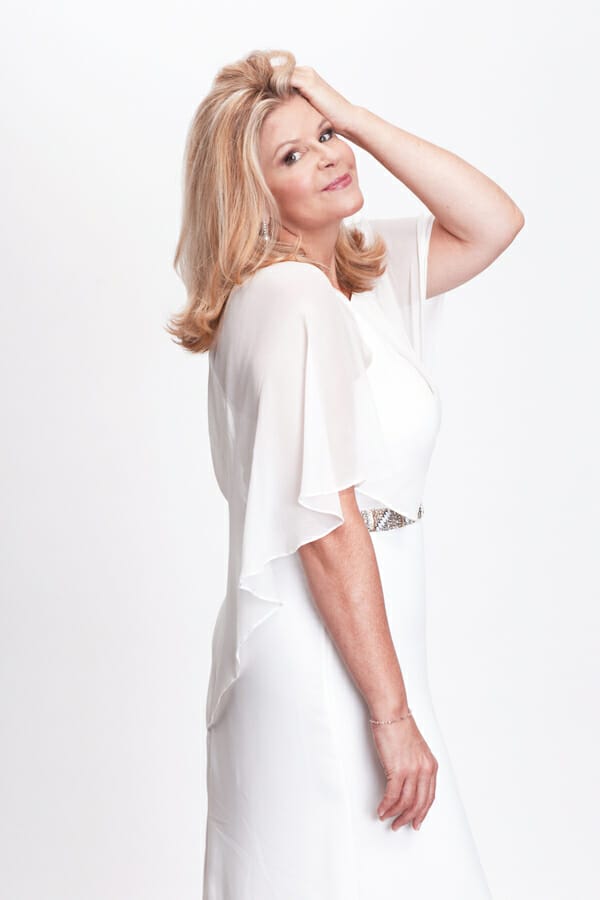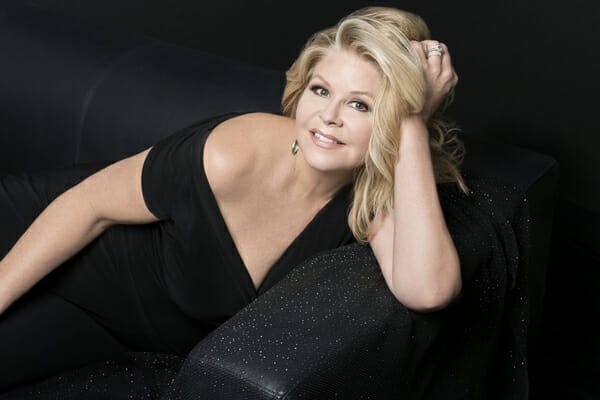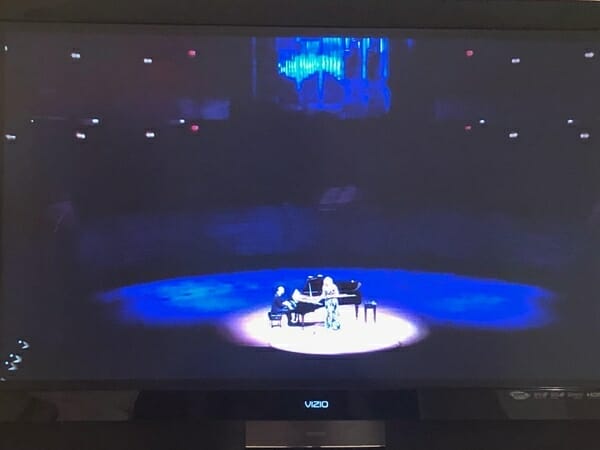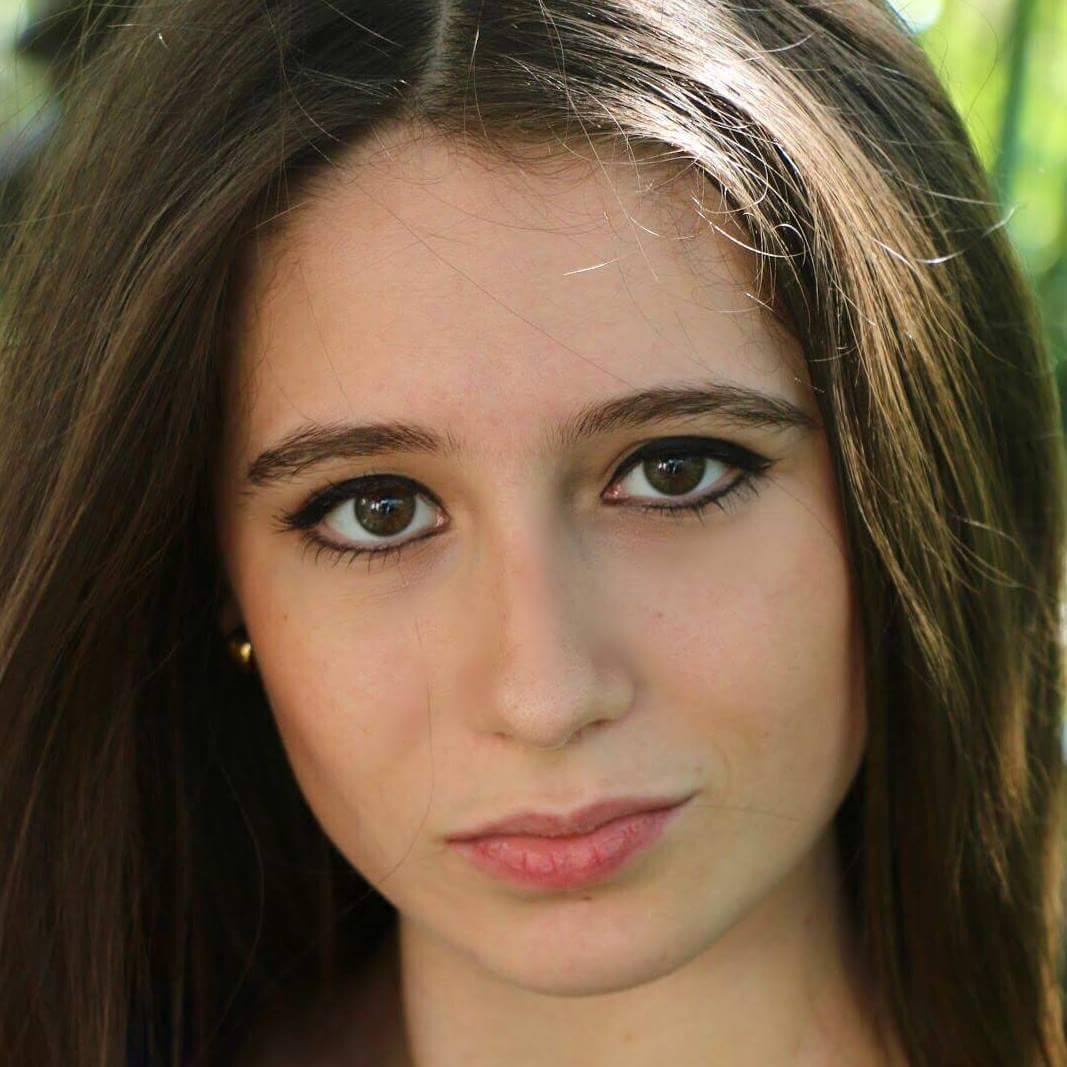At Segerstrom Hall, audiences warmly received a statuesque lady with a stylish blonde bob who strode onstage with a beaming countenance. She wore a dress splattered with purple, blue, and black -- like a particularly energetically-produced Jackson Pollock painting. The diamonds on her bracelet-clad arms and neck only heightened her air of sovereignty.
This was Susan Graham, the 58-year-old mezzo-soprano who conquered the world’s most prominent operatic stages as Cherubino in Mozart's The Marriage of Figaro, Octavian in Strauss' Der Rosenkavalier, and many other fine-tuned performances of operas ranging from composers such as Monteverdi to contemporary artists.
Graham and her accompanist, pianist Jeremy Franks, looked physically slight in their mauve-tinged spotlight, inundated as they were by the cavernous darkness of the 2000-seat hall and the organ that rose dramatically behind the performance platform. Yet from the start, Graham’s magisterial command of her instrument and her symbiosis with Franks -- prepared before a note even sounded through wordless communication, in the mysterious manner unique to hand-in-glove partnerships -- induced a hushed anticipation in the public. We apprehended perhaps in her warm and assured presence that this evening would reflect the cumulative mastery of decades of craftsmanship and immersion in various musical styles, with seventeen composers and eight languages represented.
The concept behind the program, elegantly introduced by Ms. Graham and expounded on in the intelligent program notes by Dr. Susan Youens, was refreshingly atypical for a solo vocal recital. The evening served as a sort of deconstruction of Robert Schumann’s song cycle Frauenliebe und-leben, which engages the listener on a sympathetic pilgrimage through the life of a woman presented as the archetypical ideal. Schumann, whose prolificness during the year of 1830 led to his completion of 137 songs, was undoubtedly transported to write the cycle in tribute to his own love, the pianist and composer Clara Schumann. He had just undergone an arduous period -- even involving a legal battle -- to gain the brilliant and affectionate lady’s hand in marriage. We hear Schumann’s emblematic woman undergo the first flush of young love, the self-abnegation and depth of feeling of a mature attachment to her beloved, the revelation of motherhood, and ultimately, the grief of experiencing her husband’s death. Ms. Graham then expanded each stage of her existence with a group of songs based on the same theme, in a musical ruminatio -- songs by German, Norwegian, French, and Latin American composers. Ms. Graham opened each set in the first half with a Schubert lied, which served as the impetus to other thematically related songs, while the second half closed each set with Schumann. Like the monks of the middle ages, who read their sacred texts unhurriedly in a lectio divina, savoring each word and letting its full spiritual meaning unfold without haste, the text and music’s meaning were explored in all of their variegated shades.
In this writer’s view, Ms. Graham’s instrument is youthful and robust-sounding, full-throated, and consecrated with a golden sheen. The physical sensation of her voice was akin to a caress a its velutinous sound enveloped us. At the same time it was like a prism exposing us to an array of colors. She had every technical nuance in her arsenal, from the ethereal pianissimi that she allowed to dissipate almost imperceptibly to the delightful biting quality of her chest tones -- rarely exploited by modern singers but used to devastating effect in the nakedly earthy La Maja Dolorosa (Oh Muerte Cruel!) by Enrique Granados y Campiña. It proved to be one of the most affecting moments of the evening, mirrored by the weighty and pained conclusion provided by Frank’s tolling-bell accompaniment.
Indeed, the musicians’ affinity for latin-flavored music was also apparent in their sensual interpretation of “Los Dos Miedos” from Poema en Forma de Canciones by Joaquín Turina, during which they brought to the fore the romantic pulse behind the Andalusian and French strains of the stark middle section. “Jeg Elsker Dig” from Hjertets melodier, op. 5, no. 3 (I love you) by Edvard Grieg also stood out like a luminous fresco illustrating the passion of undying love -- a love that was real and influenced by Grieg’s life-long devotion to his wife, Nina. (The piece was written as an engagement present).
Ms. Graham exuded an infectious relish in the music and her plangent and clarion sincerity ideally suited the Schumann song “Susser Freund, du blickest mich verwundert an frauenliebe und leben no. 6 by Schumann (Sweet friend, you look at me in wonder)”, particularly as she phrased a stanza in an extended elan towards quiet ecstasy (“Now you know the tears/That I can weep,/Should you not see them,/Beloved man?/Stay against my heart,/Feel its beating,/That I may press you/Ever closer”) and then ended with rapturous clarity on the “cht” sound of “lacht” (or “laughter).
Her famed proclivity for French art song was apparent in the eloquent “Absence” from Les Nuits D'Été by Hector Berlioz. Her phrasing on the line “return, return, my beloved”, sculpted attentively with the help of her simpatico collaborator Franks, was nothing short of mesmerizing as she swelled from pianissimo to fortissimo, only to inch the dynamic back exquisitely towards a softer and more elusive tone just as we thought the phrase was complete.
However, to the reviewer, what did not ring true was the way in which she sometimes constructed two similar phrases in an identical way or in other ways omitted the subtleties of an emotion, instead conveying its quintessence. The bitter lover shaking her fist at the forces that robbed her of her beloved and the woman pleading languorously for the return of her paramour, for example -- were for a moment confounded. When pieces featured abstract feelings and not a tangible narrative, they seemed, at least to this writer, to be foreign to her artistic temperament, which masters more proactive characters handily. When a piece featured an inward active impetus or was in some way physically motivated, Graham inhabited the incentives of the poet vividly, as in “Rheinlegendchen” from Des Knaben Wunderhorn by Gustave Mahler (Rhein legend), where she mimed plowing, throwing a ring into a river, and the gulping of a fish with good-natured whimsy. Indeed, she was certain to communicate to the audience with a hearty cheeriness before one of the Schumann lieder that the servant protagonist was “a strong woman” and no wilting flower, since she was able to attract and marry a man of a higher class. Although “Tout gai!” from Cinq Mélodies Populaires Grecques by Maurice Ravel did not, in this writer’s view, incorporate the innate exotic sinuousness of the harmonies and rhythms in the vocal line, it was spontaneous, requisitely airy, and full of an infectious joy that felt genuine.
For the final piece on the program, the optomistic atmosphere of the Schumann cycle gave way to Nun has du mir den ersten Schmerz getan, which transformed the D major of the previous lied to an anguished D minor as a wife wept over the form of her dead husband. Graham descended lower and lower into her register with haunting resignation as a return of a theme in the first piece of the cycle sounded in the piano, only to be cut off abruptly.
Graham and Franks let the moment resonate in silence, as if to emphasize the tragedy of the irrational and unforeseen forces that wreak havoc on the harmony we attempt to construct in our lives.
The public erupted in cries of brava and Ms. Graham graciously obliged the many requests to present an encore with Rodgers and Hammerstein's “Hello Young Lovers”, which she performed in a cremant manner. The listeners who left the hall that evening did so in a
heavenly state of mind, having experienced the catharsis of mapping the delirious happiness and suffering of a woman’s life, thus elevating their spirits from the quotidian sphere.
The fact that an artist of Susan Graham’s caliber could grace a local stage such as Segerstrom attests to the commendable efforts of the Orange County Philharmonic Society. It would be well worth the time of Californian attendees to frequent their program of events, which include in coming months concerts featuring a Grammy award-winning percussionist, the Australian Chamber Orchestra, and celebrated Cuban musicians and dancers in a celebration of Latin culture.
HIGHLY RECOMMENDED
TICKETS:
For information and tickets visit the Philharmonic Society’s website or call (949) 553-2422.
Visit Susan Graham’s website to view her schedule of upcoming performances.
Watch this video previewing Picture This Post's OPERAS WE LOVE - roundup.

